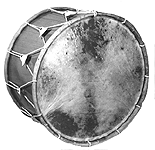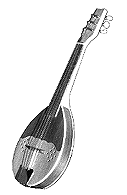|
|
Although similar to the music of the other Bulgarian regions, the folk sound of Macedonia has its specificity. To a great extent, this is a result from the different cultural influences and the heterogenous ethnography of the area,especially before the wars of 1912-1918. There is the discernable influence of the Middle Eastern music which is demonstrated through the characteristic instrumentarium employed by the Macedonian folk musicians.Good example is the wide usage of the zurna, an instrument borrowed from the Turks and not played on by the performers from other Bulgarian folk regions. |
|
The classic combination of tapan and zurnas constitutes the very core of the Macedonian sound. Traditionally, the zurnadjii perform dance music on different social occasions, such as weddings. The most interesting dances are performed exclusively by men. They are usually very slow and imbued with a sense of masculitnity and dignity.The authentic folk group formed by members of IMRO-YO has a number of such dances in its repertoire, some of which are Ginka, Boinoto, Gaida Avasi,Ispaiche etc. |

|

TAMBURA |
The so called chalgiiiski songs represent one of the most interesting genre in the rich musical tradition of Macedonia. Their most characteristic feature is the complete unison between the vocal and the instrumental parts.The voice and the instruments follow an identical melodic line that each one reproduces in the octave best suited for its range.The chalgijski ensemble includes instruments taken from the West (violin, clarinet), typically Middle Eastern ones (tarambuka, known also as dumbek, out), and the ubiquitous tambura, which is probably one of the most common instruments in the Macedonian folk music. |
|
Tamburas have a rhythmic, as well as leading melodic function in the mixed folk ensemble which may include other instruments, such as kaval (a kind of flute), gaida (Bulgarian bagpipe which has a bit different tuning in Macedonia, as compared to the gaidas coming from the other folk provinces, chiefly the Rhodope mountains). Just like in Dalmatia, the tambura ensembles are quite typical. Usually, they comprise various kinds of string instruments, such as brach, bisernica etc. The Sofia based folk ensemble Goce Delchev has one of the largest collections of unique string instruments brought to Bulgaria by the refugees who came from Aegean Macedonia in the 1920s. |
